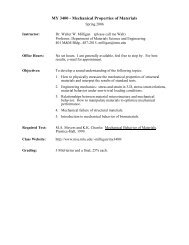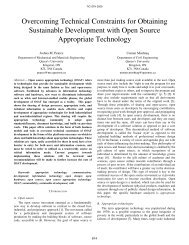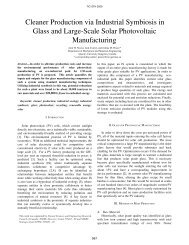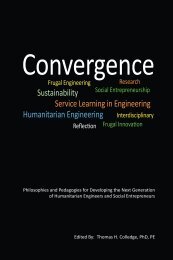Underfill Flow as Viscous Flow Between Parallel Plates Driven - Profile
Underfill Flow as Viscous Flow Between Parallel Plates Driven - Profile
Underfill Flow as Viscous Flow Between Parallel Plates Driven - Profile
You also want an ePaper? Increase the reach of your titles
YUMPU automatically turns print PDFs into web optimized ePapers that Google loves.
136 IEEE TRANSACTIONS ON COMPONENTS, PACKAGING, AND MANUFACTURING TECHNOLOGY-PART C, VOL. 19, NO. 2, APRIL 1996<br />
Consider the c<strong>as</strong>e where the flip-chip is oriented vertically<br />
such that the underfill flows from top to bottom aided by<br />
the hydrostatic pressure induced by gravity acting on the<br />
underfill. Assuming underfill with a ycose value of 0.015<br />
N/m w<strong>as</strong> used on a chip with a 75 pm standoff (separation<br />
distance), the capillary pressure given by (7) would be 395<br />
Pa. The median hydrostatic pressure generated during the<br />
flow would be pgH/2 where p is the m<strong>as</strong>s density of the<br />
underfill, g = 9.81 m/s2, and H is the chip size. A typical<br />
underfill m<strong>as</strong>s density of 1600 kg/m3 on a 10 mm square<br />
flip-chip would generate a median hydrostatic pressure of 78<br />
Pa. Since the hydrostatic pressure is only about 1/5 of the<br />
capillary pressure, it is unlikely to significantly enhance the<br />
flow rate, especially when the gap (separation distance) is<br />
small. Vacuum enhancements can generate driving pressures<br />
of up to one atmosphere (lo5 Pa). Since this is more than<br />
250 times the capillary pressure, the vacuum enhancement will<br />
have a significant effect on the flow rate. An example of the<br />
use of vacuum to enhance underfill flow h<strong>as</strong> been demonstrated<br />
by Banerji et al. [21].<br />
V. CONCLUSION<br />
An exact model w<strong>as</strong> developed for understanding the flow<br />
time (t) for qu<strong>as</strong>isteady, laminar flow between parallel<br />
plates driven by capillary action, <strong>as</strong> a function of flow<br />
distance (L), separation distance (h), wetting angle (e),<br />
surface tension (y), and the absolute viscosity (p). The<br />
flow time is given by<br />
The flow time for viscous flow between parallel plates<br />
driven by capillary action is inversely proportional to the<br />
surface tension, separation distance and cosine of the wetting<br />
angle, and directly proportional to the viscosity and<br />
the square of the flow distance. This model agreed well<br />
with experimental results of a typical underfill material<br />
flowing between plates of gl<strong>as</strong>s and ceramic.<br />
The flow rate of an underfill is strongly related to two<br />
underfill material properties: surface tension (y) and<br />
viscosity (p). The quantity<br />
w<strong>as</strong> defined <strong>as</strong> the coescient of planar penetrance (Q)<br />
where 8 is the wetting angle of the underfill to the planes.<br />
The ycos8 term can be determined by me<strong>as</strong>uring the<br />
capillary rise of a progressing meniscus.<br />
This parameter me<strong>as</strong>ures the penetrating power of a<br />
liquid into a gap between parallel plates, and h<strong>as</strong> units<br />
of velocity. This parameter w<strong>as</strong> strongly related to the<br />
temperature of the underfill material.<br />
Gravity will not significantly enhance the flow rate of<br />
underfill materials flowing under flip-chips. Vacuum enhancement,<br />
however, can generate pressures of more than<br />
250 times the capillary pressure, and will effectively<br />
enhance underfill flow rates.<br />
VI. RECOMMENDATIONS<br />
In order to characterize the flow behavior of an underfill<br />
material under a flip-chip, the coeficient of planar<br />
penetrance should be specified at the recommended flow<br />
temperature.<br />
Gravity (inclined or vertical flow) should not be pursued<br />
<strong>as</strong> a method to enhance underfill flow rates. Vacuum<br />
enhancements, however, should be pursued.<br />
This work does not consider the effects of surface roughness,<br />
solder bumps, flux residues, or other obstructions<br />
on the underfill flow. This model also does not consider<br />
non-Newtonian flow behavior. A more complicated model<br />
could be developed to include these factors, however its<br />
usefulness would be limited due to additional complexity.<br />
An empirical approach, b<strong>as</strong>ed on the simple model shown<br />
here, is recommended for optimizing processes including<br />
these other factors.<br />
ACKNOWLEDGMENT<br />
The authors would like to thank L. Powers-Maloney and T.<br />
Og<strong>as</strong>awara for their characterization of the underfill properties,<br />
to C. Avila, M. Evans, J. Glazer, H. Holder, and G. Margaritis<br />
for their editing, encouragement and support, and to J. A.<br />
Emerson for helpful comments on underfill surface tension<br />
values.<br />
REFERENCES<br />
[I] R. R. Tummala and E. J. Rym<strong>as</strong>zewski, Microelectronics Packaging<br />
Handbook. New York: Van Nostrand Reinhold, 1989, pp. 366-391.<br />
[2] K. DeHaven and J. Dietz, “Controlled collapse chip connection<br />
(C4)-An enabling technology,” in Proc. 44th ECTC, 1994, pp. 1-6.<br />
[3] M. Kelly and J. Lau, “Low cost solder bumped flip-chip MCM-L<br />
demonstration,” Circuit World, vol. 21, no. 3, pp. 25-28, Mar. 1995.<br />
[4] B. Wun and J. Lau, “Characterization and evaluation of the underfill<br />
encapsulants for flip chip <strong>as</strong>sembly,” Circuit World, vol. 21, no. 4, pp.<br />
14-17, July 1995.<br />
[5] Y. Tsukada et al., “Reliability and stress analysis of encapsulated flipchip<br />
joint on epoxy b<strong>as</strong>e printed circuit board, advances in electronic<br />
packaging,” in Proc. 1992 Joint ASME/JSME Con$ Eleciron. Packaging,<br />
1992, vol. 2, pp. 827-835.<br />
[6] A. Rai et al., “COB (chip on board) technology: Flip chip bonding onto<br />
ceramic substrates and PWB (printed wiring boards),” in Proc. I990 iat.<br />
Symp. Microelectron. (ISHM), 1990, pp. 474481.<br />
[7] A. Rai et al., “Flip-chip COB technology on PWB,” in Proc. 1MC 1992,<br />
Yokohama, Japan, June 3, 1992, pp. 144-149.<br />
[8] Y. Tsukada et al.> “Surface laminar circuit packaging,” in Proc. 42nd<br />
ECTC, 1992, pp. 22-27.<br />
[9] J. Lau, “Experimental and analytical studies of encapsulated flip-chip<br />
solder bumps on surface laminar circuit boards,” Circuit World, vol. 19,<br />
no. 3, pp. 18-24, 1993.<br />
[lo] J. Kloeser el al., “Low-cost flip-chip bonding on FR-4 boards” Circuit<br />
World, vol. 22, no. 1, pp. 18-21, Oct. 1995.<br />
[ll] F. Nakano et al., “Resin-insertion effect on thermal cycle resistivity of<br />
flip-chip mounted LSI devices,” in Proc. 1987 Int. Symp. Microelectron.<br />
(ISHM), 1987, pp. 536-541.<br />
[I21 D. Suryanarayana et al., “Enhancement of flip-chip fatigue life by<br />
encapsulation,” IEEE Trans. Comp., Packag., Munufact. Technol., vol.<br />
14, no. I, pp. 218-223, Mar. 1991.<br />
[13] D. Suryanarayana et al., “Encapsulants used in flip-chip packages,”<br />
IEEE Trans. Comp., Packag., Manufact. Technol., vol. 16, no. 8, pp.<br />
858-862, Dec. 1993.<br />
[14] D. W. Wang and K. I. Papathom<strong>as</strong>, “Encapsulant for fatigue life<br />
enhancement of controlled collapse chip connection (C4),” IEEE Trans.<br />
Comp., Packag., Manufact. Technol., vol. 16, no. 8, pp. 863-867, Dec.<br />
1993.<br />
[lS] J. Clementi et al., “Flip-Chip encapsulation on ceramic substrates,” in<br />
Proc. 43rd ECTC, 1993, pp. 175-181.








